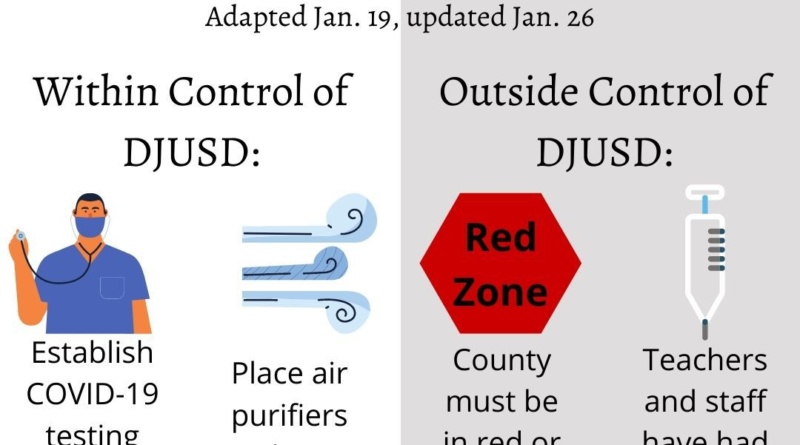Breaking down the hybrid model
By Emily Chapman and Renee Xiang,
BlueDevilHUB.com Staff–
Though plans to return to in-person learning have been in the works for quite some time, adoption of a hybrid model has been under heavy discussion these past few weeks, with the district board and faculty making significant progress in creating conditions for a COVID-safe return.
What are the conditions for hybrid return?
On Jan. 19, the Davis Joint Unified School District Board of Education passed a motion establishing specific conditions which need to be met in order to move forward with a hybrid return.
These conditions were categorized into “external and internal conditions,” according to Board President Joe DiNunzio.
External conditions include factors such as community spread of the virus and staff vaccination. As part of the Jan. 19 motion, DiNunzio and fellow board members decided that the hybrid model should not be implemented until Yolo County remains in the red tier for at least two weeks and returning teachers and staff have had access to both doses of the vaccine.
A public statement from Superintendent John Bowes released on Jan. 22 reads, “while these conditions are beyond the control of DJUSD, [the district is] in regular communication with the Yolo County Public Health Officer, monitoring the county’s infection rate.”
With regards to internal conditions, DJUSD has been working alongside Healthy Davis Together to coordinate safety protocols in compliance with the California Department of Public Health’s requirements.
Primarily, these protocols consist of asymptomatic testing and contact tracing procedures for students and staff on campus.
Currently, there are mobile testing sites located at four different schools throughout the district — Patwin, Harper, Montgomery and Valley Oak. With the small cohorts currently attending classes on campus, Healthy Davis Together personnel at each of these sites are conducting 4-15 spit tests each day. They are planning to expand to accommodate the inflow of students and staff when they return to campus.
“We were asked [by the district] to start out as a pilot. This is the first time we actually have a fully mobile operation at each of these school sites. So in a way, I almost feel relieved that we had the luxury of starting small, it gives us a chance to just set up the operation. […] We do look forward to being able to serve and test a lot more students,” said Sheri Belafsky, the medical director for Healthy Davis Together.
The organization is also behind efforts to manage environmental testing technology at each school site.
DJUSD has already successfully installed MERV-13 air filters at each school, and part of Healthy Davis Together’s partnership with the district entails “[testing] those air filters to see if perhaps there’s somebody in the classroom that might have been shedding [the] virus” as well as “[monitoring] the air flow in the classrooms and schools,” according to Todd Stoltz, who is leading Healthy Davis Together’s Technology and Innovation Corps.
All of these measures work to meet the internal conditions set by the board. Though there are still some campuses which don’t have operational testing centers, these will be set up in the course of the next week.
What is the hybrid model?
The hybrid model, approved by the Board for Secondary Education on Jan.1, will follow a similar schedule to the current quarter layout but with the integration of synchronous learning.
“Because the California Department of Public Health [requires] that we have to maintain a six-foot distance and reduce the number of students in any classroom, we can only accommodate at a maximum half the number of students in any given class,” DiNunzio said.
All students will be assigned one of two groups by household: cohort A or cohort B, each of which will have in-person classes two days per week. Additionally, there will be a cohort C consisting of students who opt out of in-person learning.
Cohort A will be in person Mondays and Tuesdays while cohort B will be in person Thursdays and Fridays. Everyone will be online on Wednesdays. Students who choose to be in person will remain on campus until lunch.
While one cohort is in person, the other cohorts will be engaging with the class online through synchronous learning, meaning teachers will be bringing Zoom into the classroom.
“All students will be receiving the same instruction, it’s just some will be physically in the classroom and some will not,” DiNunzio said.

What next?
Currently, Yolo County resides within the purple tier and will remain there as long as there are more than seven new cases per 100,000 residents or more than 8 percent of test results reported positive over seven days.
Local health care workers are also in the process of vaccinating the 65 and up age group — with current vaccine availability and resources, this may take months. Teachers and staff are in line to receive vaccinations after this group, and will need to wait an additional two weeks after they receive their second dose to return to campus.
The board has set May 3 as a cutoff date, after which a return will no longer be feasible for this school year.
“We want to return to campus as soon as the conditions allow. Ideally, that will be before the week of May 3, but we also wanted to set an upper boundary, at which point the amount of time and effort that it would take to transition onto campus in a hybrid model just wouldn’t be realistic,” DiNunzio said.
Past this cutoff date, plans for a return remain unclear for the 2021-22 school year — including what safety protocols will look like in the fall, whether secondary schools will keep the current quarter system, and how much of the learning will take place on campus.
“We’re planning for fall that looks like a full return to campus. And that’s sort of our default for the moment,” DiNunzio said. “[But] if for some reason, things aren’t where we expect them to be, we need to have a backup plan, which is likely to be some kind of a hybrid education.”



